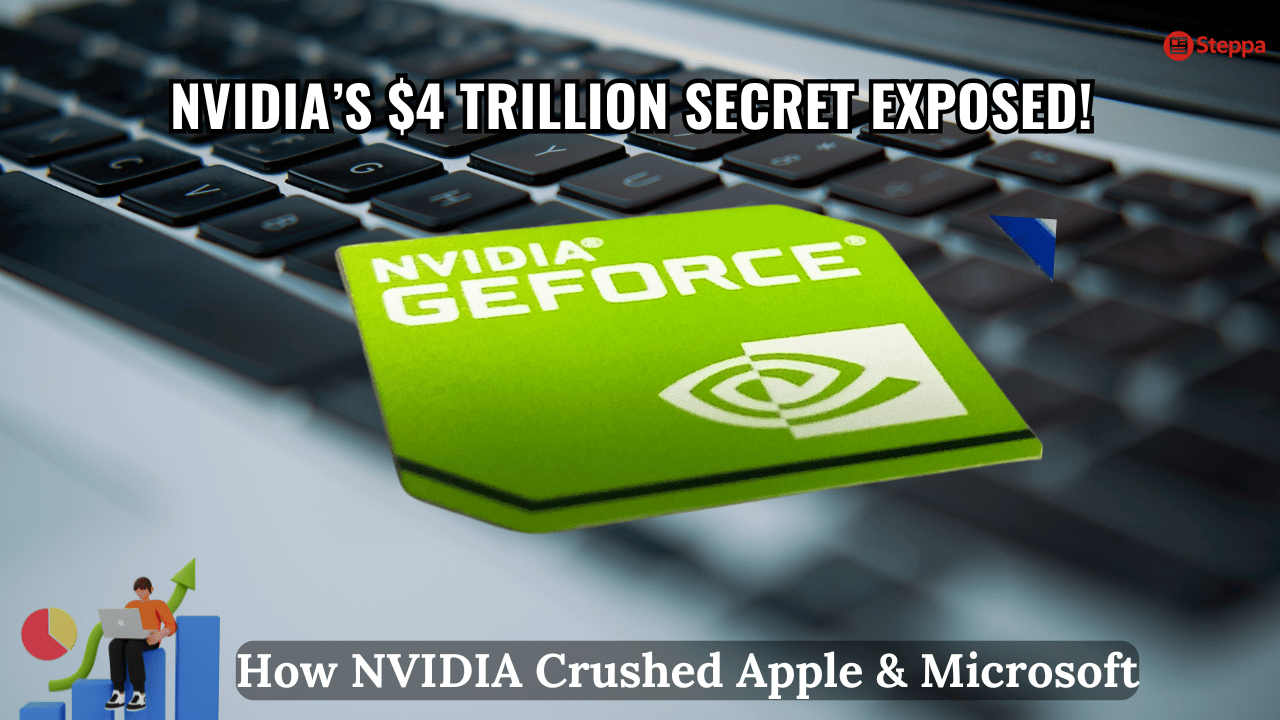NVIDIA’s $4 Trillion Valuation Secret EXPOSED!
Okay, buckle up—$4 trillion isn’t just some number. It’s a mind-blowing valuation. And here’s the kicker: the world’s most valuable company now? Not Apple. Not Microsoft. It’s NVIDIA $4 trillion valuation. Let me tell you how a gaming GPU maker quietly became the AI overlord.
From PC Games to AI Goldmine
Back in 1993, NVIDIA hopped into the GPU race. Gamers loved their GeForce cards. That’s fair enough—they made amazing graphics. But while everyone else focused on CPUs, NVIDIA saw a bigger picture. They suspected their GPUs could be the brains behind… AI.
That One Smart Prediction
Here’s where things get juicy. As machine learning took off, GPUs—originally made for rendering graphics—were suddenly perfect for massive parallel math. Enter the Tesla, A100, and H100 chips. These aren’t your average graphics cards. They’re the backbone of ChatGPT runs, big-data centres, even robotics brains.
Again to be honest—no one expected GPUs to steal AI’s thunder. But NVIDIA basically bet the farm on them. And it paid off.
“We built for AI before it went mainstream,” says Jensen Huang
That’s Jensen Huang, NVIDIA’s CEO and co-founder, laying it straight:
“We saw what was coming. We didn’t wait for AI to be mainstream—we built for it before anyone else was ready.”
Bold claim, but with a $4 trillion valuation, it’s hard to argue.
The Cloud Just Needed Them
Think about it. AWS, Azure, GCP—they all need insane compute power. When AI models became mainstream in 2023–24, NVIDIA’s chips were the only game in town. Demand shot up so fast, they sold out for months.
That scarcity isn’t by accident. NVIDIA planned this. They had years of R&D and a pipeline ready when the world woke up to generative AI. Others were scrambling. NVIDIA was delivering.
Building an Empire, One Smart Move at a Time
NVIDIA didn’t just sell chips. They acquired Mellanox, which handles data movement inside data centres. They invested heavily in CUDA, a software platform that developers build AI models on.
They partnered with giants—Microsoft, Amazon, Meta. These companies didn’t just buy chips—they built infrastructures around them.
And here’s the rub: you can’t just switch ecosystems after spending years building them. NVIDIA has deep hooks now.
Quick Snapshot: Why NVIDIA Dominates
| Strength | Why It Matters |
| Industry-Leading GPUs | Roughly 10–20x faster for AI tasks |
| CUDA Software Stack | Developers can’t easily move to rivals |
| Networking (Mellanox) | Controls traffic inside cloud data centres |
| Early AI Bet | No need to pivot—they were already there |
| Strategic Partnerships | Evergreen demand from big tech players |
Competitors? Sure—but On the Back Foot
AMD and Intel are chasing. So are new startups. But NVIDIA isn’t just ahead in chips—they’re ahead in ecosystem. When you’re powering AI from training to deployment, that matters. A lot.
What Happens Next?
No signs of slowing down. NVIDIA is aggressively investing in things like robotics, self-driving systems, AI-driven healthcare, and even real-time virtual worlds. They’re not me-too-ing—they’re shaping what comes next.
Real Challenges Ahead
Let’s be honest—no empire is unblemished. Supply chain disruptions, antitrust scrutiny, rising competition. Yet, the company says it’s well-prepared.
In a Q2 2025 earnings call, CFO Colette Kress admitted they saw logistical bumps but added:
“We have mitigations in place and are scaling production to meet demand without sacrificing margins.”
Bottom line—they’re aware and they’re ready.
Final Thoughts
NVIDIA’s journey from a niche GPU maker to a $4 trillion powerhouse isn’t just business—it’s a masterclass in foresight and execution. They bet early on AI, built a rock-solid ecosystem, and delivered when it mattered most. That’s not luck. That’s strategy.
FAQs—NVIDIA’s Record-Breaking Rise Explained
1. How did NVIDIA skyrocket to $4 trillion so fast?
By capturing massive AI compute demand early and cementing dominance in data centres.
2. Why are GPUs so crucial for AI?
They handle heavy parallel math—perfect for neural networks.
3. Did NVIDIA invent AI chips?
Not exactly. But they adapted gaming GPUs brilliantly for AI workloads.
4. Can other chip firms catch up?
They’re trying. But NVIDIA has CUDA, a network business, and early partnerships. It’s tough to match.
5. What exactly is CUDA?
NVIDIA’s software toolkit—developers use it to write AI software that works with their GPUs.
6. What’s this Mellanox deal?
It gave NVIDIA fast, efficient networking within data centres—crucial for large-model training.
7. Are supply issues still a worry?
They’ve had hiccups, but CFO says they’re on top of it.
8. What’s next on their roadmap?
Think robotics, autonomous vehicles, AI-driven healthcare, virtual worlds.
9. Will NVIDIA stay on top?
With great tech, ecosystem, and partners—it’s likely, but nothing’s guaranteed.
10. Can smaller companies use NVIDIA chips?
Yes—but they’re often backlogged. High-volume users get priority.
